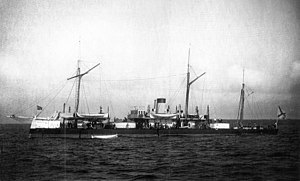Admiral Spiridov-class monitor

Admiral Chichagov at anchor
|
|
| Class overview | |
|---|---|
| Name: | Admiral Spiridov |
| Builders: | Semiannikov & Poletika Shipyard, Saint Petersburg |
| Operators: |
|
| Preceded by: | Admiral Lazarev class |
| Succeeded by: | Russian ironclad Petr Veliky |
| Cost: | 1,177,500 Rubles |
| Built: | 1866–1869 |
| Completed: | 2 |
| Scrapped: | 2 |
| General characteristics (as built) | |
| Type: | Monitor |
| Displacement: | 3,505–3,587 long tons (3,561–3,645 t) |
| Length: | 254 ft (77.4 m) (waterline) |
| Beam: | 43 ft (13.1 m) |
| Draft: | 21 ft (6.4 m) |
| Installed power: |
|
| Propulsion: |
|
| Speed: | 10 knots (19 km/h; 12 mph) |
| Range: | 1,400 nmi (2,600 km; 1,600 mi) at 10 knots (19 km/h; 12 mph) |
| Complement: | 280 officers and crewmen |
| Armament: |
|
| Armor: |
|
The Admiral Spiridov class were a pair of monitors built for the Imperial Russian Navy in the late 1860s. The sister ships were assigned to the Baltic Fleet upon completion and remained there for their entire careers. Aside from several accidental collisions and one grounding, their careers were uneventful. They were reclassified as coast-defense ironclads in 1892 before they became training ships in 1900. The Admiral Spiridovs were stricken from the Navy List in 1907; one ship became a stationary target and the other a coal-storage barge. Their ultimate fates are unknown.
By late 1863, the Russian Admiralty Board had begun planning for the second generation of ironclads to succeed those ships then under construction. They ordered eight ships, two fully rigged seagoing types and six coastal defense ships, in March 1864. The British shipbuilder Charles Mitchell submitted four different designs for the coastal defense vessels, two broadside ironclads and two turret ships. The Shipbuilding Technical Committee decided in August that the broadside designs would be based on the hull shape of the earlier Pervenets-class ironclad for better seaworthiness, but they would be armed with fewer, but more powerful guns, than the numerous smoothbore guns of the older ships. Two variants were worked out that differed in the fineness of the hull and draft.
...
Wikipedia
